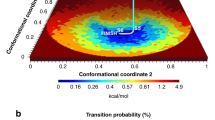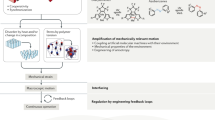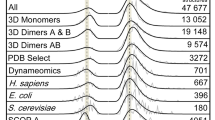Abstract
Because proteins are central to cellular function, researchers have sought to uncover the secrets of how these complex macromolecules execute such a fascinating variety of functions. Although static structures are known for many proteins, the functions of proteins are governed ultimately by their dynamic character (or 'personality'). The dream is to 'watch' proteins in action in real time at atomic resolution. This requires addition of a fourth dimension, time, to structural biology so that the positions in space and time of all atoms in a protein can be described in detail.
This is a preview of subscription content, access via your institution
Access options
Subscribe to this journal
Receive 51 print issues and online access
$199.00 per year
only $3.90 per issue
Buy this article
- Purchase on Springer Link
- Instant access to full article PDF
Prices may be subject to local taxes which are calculated during checkout







Similar content being viewed by others
References
Chandler, D. Roles of classical dynamics and quantum dynamics on activated processes occurring in liquids. J. Stat. Phys. 42, 49–67 (1986).
Olsson, M. H. M., Parson, W. W. & Warshel, A. Dynamical contributions to enzyme catalysis: critical tests of a popular hypothesis. Chem. Rev. 106, 1737–1756 (2006).
Benkovic, S. J. & Hammes-Schiffer, S. A perspective on enzyme catalysis. Science 301, 1196–1202 (2003).
Gertner, B. J., Wilson, K. R. & Hynes, J. T. Nonequilibrium solvation effects on reaction-rates for model SN2 reactions in water. J. Chem. Phys. 90, 3537–3558 (1989).
Schliwa, M. (ed.) Molecular Motors (Wiley, Weinheim, 2003).
Kolomeisky, A. B. & Fisher, M. E. Molecular motors: a theorist's perspective. Annu. Rev. Phys. Chem. 58, 675–695 (2007).
Lazaridis, T. & Karplus, M. 'New view' of protein folding reconciled with the old through multiple unfolding simulations. Science 278, 1928–1931 (1997).
Leopold, P. E., Montal, M. & Onuchic, J. N. Protein folding funnels — a kinetic approach to the sequence structure relationship. Proc. Natl Acad. Sci. USA 89, 8721–8725 (1992).
Wolynes, P. G. Recent successes of the energy landscape theory of protein folding and function. Q. Rev. Biophys. 38, 405–410 (2005).
Austin, R. H., Beeson, K. W., Eisenstein, L., Frauenfelder, H. & Gunsalus, I. C. Dynamics of ligand binding to myoglobin. Biochemistry 14, 5355–5373 (1975).
Frauenfelder, H., Sligar, S. G. & Wolynes, P. G. The energy landscapes and motions of proteins. Science 254, 1598–1603 (1991).
Frauenfelder, H., Petsko, G. A. & Tsernoglou, D. Temperature-dependent X-ray diffraction as a probe of protein structural dynamics. Nature 280, 558–563 (1979).
Brooks, C. L. & Karplus, M. Solvent effects on protein motion and protein effects on solvent motion — dynamics of the active-site region of lysozyme. J. Mol. Biol. 208, 159–181 (1989).
Fenimore, P. W., Frauenfelder, H., McMahon, B. H. & Parak, F. G. Slaving: solvent fluctuations dominate protein dynamics and functions. Proc. Natl Acad. Sci. USA 99, 16047–16051 (2002).
Beece, D. et al. Solvent viscosity and protein dynamics. Biochemistry 19, 5147–5157 (1980).
Fenimore, P. W., Frauenfelder, H., McMahon, B. H. & Young, R. D. Bulk-solvent and hydration-shell fluctuations, similar to α- and β-fluctuations in glasses, control protein motions and functions. Proc. Natl Acad. Sci. USA 101, 14408–14413 (2004).
Shakhnovich, E. Protein folding thermodynamics and dynamics: where physics, chemistry, and biology meet. Chem. Rev. 106, 1559–1588 (2006).
Lindorff-Larsen, K., Rogen, P., Paci, E., Vendruscolo, M. & Dobson, C. M. Protein folding and the organization of the protein topology universe. Trends Biochem. Sci. 30, 13–19 (2005).
Bourgeois, D. & Royant, A. Advances in kinetic protein crystallography. Curr. Opin. Struct. Biol. 15, 538–547 (2005).
Schlichting, I. et al. The catalytic pathway of cytochrome P450cam at atomic resolution. Science 287, 1615–1622 (2000).
Englander, S. W. Hydrogen exchange and mass spectrometry: a historical perspective. J. Am. Soc. Mass Spectrom. 17, 1481–1489 (2006).
Bai, Y. W. Protein folding pathways studied by pulsed- and native-state hydrogen exchange. Chem. Rev. 106, 1757–1768 (2006).
Mittermaier, A. & Kay, L. E. New tools provide new insights in NMR studies of protein dynamics. Science 312, 224–228 (2006).
Kay, L. E. NMR studies of protein structure and dynamics. J. Magn. Reson. 173, 193–207 (2005).
Palmer, A. G. NMR characterization of the dynamics of biomacromolecules. Chem. Rev. 104, 3623–3640 (2004).
Kern, D., Eisenmesser, E. Z. & Wolf-Watz, M. Enzyme dynamics during catalysis measured by NMR spectroscopy. Methods Enzymol. 394, 507–524 (2005).
Pervushin, K., Riek, R., Wider, G. & Wuthrich, K. Attenuated T-2 relaxation by mutual cancellation of dipole–dipole coupling and chemical shift anisotropy indicates an avenue to NMR structures of very large biological macromolecules in solution. Proc. Natl Acad. Sci. USA 94, 12366–12371 (1997).
Sprangers, R., Gribun, A., Hwang, P. M., Houry, W. A. & Kay, L. E. Quantitative NMR spectroscopy of supramolecular complexes: dynamic side pores in ClpP are important for product release. Proc. Natl Acad. Sci. USA 102, 16678–16683 (2005).
Palmer, A. G., Grey, M. J. & Wang, C. Y. Solution NMR spin relaxation methods for characterizing chemical exchange in high-molecular-weight systems. Methods Enzymol. 394, 430–465 (2005).
Tugarinov, V. & Kay, L. E. Quantitative C-13 and H-2 NMR relaxation studies of the 723-residue enzyme malate synthase G reveal a dynamic binding interface. Biochemistry 44, 15970–15977 (2005).
Sprangers, R. & Kay, L. E. Quantitative dynamics and binding studies of the 20S proteasome by NMR. Nature 445, 618–622 (2007).
Horst, R. et al. Direct NMR observation of a substrate protein bound to the chaperonin GroEL. Proc. Natl Acad. Sci. USA 102, 12748–12753 (2005).
Christodoulou, J. et al. Heteronuclear NMR investigations of dynamic regions of intact Escherichia coli ribosomes. Proc. Natl Acad. Sci. USA 101, 10949–10954 (2004).
Loria, J. P., Rance, M. & Palmer, A. G. A relaxation-compensated Carr–Purcell–Meiboom–Gill sequence for characterizing chemical exchange by NMR spectroscopy. J. Am. Chem. Soc. 121, 2331–2332 (1999).
Eisenmesser, E. Z., Bosco, D. A., Akke, M. & Kern, D. Enzyme dynamics during catalysis. Science 295, 1520–1523 (2002).
Eisenmesser, E. Z. et al. Intrinsic dynamics of an enzyme underlies catalysis. Nature 438, 117–121 (2005).
Fischer, G., Wittmannliebold, B., Lang, K., Kiefhaber, T. & Schmid, F. X. Cyclophilin and peptidyl-prolyl cis–trans isomerase are probably identical proteins. Nature 337, 476–478 (1989).
Takahashi, N., Hayano, T. & Suzuki, M. Peptidyl-prolyl cis–trans isomerase is the cyclosporin-A-binding protein cyclophilin. Nature 337, 473–475 (1989).
Loria, J. P., Rance, M. & Palmer, A. G. A TROSY CPMG sequence for characterizing chemical exchange in large proteins. J. Biomol. NMR 15, 151–155 (1999).
Tollinger, M., Skrynnikov, N. R., Mulder, F. A. A., Forman-Kay, J. D. & Kay, L. E. Slow dynamics in folded and unfolded states of an SH3 domain. J. Am. Chem. Soc. 123, 11341–11352 (2001).
Michalet, X., Weiss, S. & Jager, M. Single-molecule fluorescence studies of protein folding and conformational dynamics. Chem. Rev. 106, 1785–1813 (2006).
Myong, S., Stevens, B. C. & Ha, T. Bridging conformational dynamics and function using single-molecule spectroscopy. Structure 14, 633–643 (2006).
Yang, H. et al. Protein conformational dynamics probed by single-molecule electron transfer. Science 302, 262–266 (2003).
Deniz, A. A., Mukhopadhyay, S. & Lemke, E. A. Single-molecule biophysics: at the interface of biology, physics and chemistry. J. R. Soc. Interface advance online publication, doi:10.1098/rsif.2007.1021 (22 May 2007).
Stryer, L. & Haugland, R. P. Energy transfer — a spectroscopic ruler. Proc. Natl Acad. Sci. USA 58, 719–726 (1967).
Diez, M. et al. Proton-powered subunit rotation in single membrane-bound F0F1-ATP synthase. Nature Struct. Mol. Biol. 11, 135–141 (2004).
Adcock, S. A. & McCammon, J. A. Molecular dynamics: survey of methods for simulating the activity of proteins. Chem. Rev. 106, 1589–1615 (2006).
McCammon, J. A., Gelin, B. R. & Karplus, M. Dynamics of folded proteins. Nature 267, 585–590 (1977).
Scheraga, H. A., Khalili, M. & Liwo, A. Protein-folding dynamics: overview of molecular simulation techniques. Annu. Rev. Phys. Chem. 58, 57–83 (2007).
Karplus, M. & Kushick, J. N. Method for estimating the configurational entropy of macromolecules. Macromolecules 14, 325–332 (1981).
Ma, J. P. & Karplus, M. Ligand-induced conformational changes in ras p21: a normal mode and energy minimization analysis. J. Mol. Biol. 274, 114–131 (1997).
Haliloglu, T., Bahar, I. & Erman, B. Gaussian dynamics of folded proteins. Phys. Rev. Lett. 79, 3090–3093 (1997).
Jacobs, D. J., Rader, A. J., Kuhn, L. A. & Thorpe, M. F. Protein flexibility predictions using graph theory. Proteins 44, 150–165 (2001).
Wells, S., Menor, S., Hespenheide, B. & Thorpe, M. F. Constrained geometric simulation of diffusive motion in proteins. Phys. Biol. 2, S127–S136 (2005).
Hamelberg, D., Mongan, J. & McCammon, J. A. Accelerated molecular dynamics: a promising and efficient simulation method for biomolecules. J. Chem. Phys. 120, 11919–11929 (2004).
Paci, E. & Karplus, M. Forced unfolding of fibronectin type 3 modules: an analysis by biased molecular dynamics simulations. J. Mol. Biol. 288, 441–459 (1999).
Schlitter, J., Engels, M., Kruger, P., Jacoby, E. & Wollmer, A. Targeted molecular-dynamics simulation of conformational change — application to the T–R transition in insulin. Mol. Simul. 10, 291–308 (1993).
Roux, B. The calculation of the potential of mean force using computer simulations. Comput. Phys. Commun. 91, 275–282 (1995).
Dellago, C. & Bolhuis, P. G. Transition path sampling simulations of biological systems. Top. Curr. Chem. 268, 291–317 (2007).
Merritt, E. A. Expanding the model: anisotropic displacement parameters in protein structure refinement. Acta Crystallogr. D Biol. Crystallogr. 55, 1109–1117 (1999).
Schotte, F., Soman, J., Olson, J. S., Wulff, M. & Anfinrud, P. A. Picosecond time-resolved X-ray crystallography: probing protein function in real time. J. Struct. Biol. 147, 235–246 (2004).
Frauenfelder, H., McMahon, B. H. & Fenimore, P. W. Myoglobin: the hydrogen atom of biology and a paradigm of complexity. Proc. Natl Acad. Sci. USA 100, 8615–8617 (2003).
Franks, W. T. et al. Magic-angle spinning solid-state NMR spectroscopy of the β1 immunoglobulin binding domain of protein G (GB1): N-15 and C-13 chemical shift assignments and conformational analysis. J. Am. Chem. Soc. 127, 12291–12305 (2005).
Lorieau, J. L. & McDermott, A. E. Conformational flexibility of a microcrystalline globular protein: order parameters by solid-state NMR spectroscopy. J. Am. Chem. Soc. 128, 11505–11512 (2006).
Akke, M., Bruschweiler, R. & Palmer, A. G. NMR order parameters and free-energy — an analytical approach and its application to cooperative Ca2+ binding by calbindin-D9k . J. Am. Chem. Soc. 115, 9832–9833 (1993).
Jarymowycz, V. A. & Stone, M. J. Fast time scale dynamics of protein backbones: NMR relaxation methods, applications, and functional consequences. Chem. Rev. 106, 1624–1671 (2006).
Lee, A. L., Sharp, K. A., Kranz, J. K., Song, X. J. & Wand, A. J. Temperature dependence of the internal dynamics of a calmodulin–peptide complex. Biochemistry 41, 13814–13825 (2002).
Li, Z. G., Raychaudhuri, S. & Wand, A. J. Insights into the local residual entropy of proteins provided by NMR relaxation. Protein Sci. 5, 2647–2650 (1996).
Yang, D. W. & Kay, L. E. Contributions to conformational entropy arising from bond vector fluctuations measured from NMR-derived order parameters: application to protein folding. J. Mol. Biol. 263, 369–382 (1996).
Brokx, R. D., Lopez, M. M., Vogel, H. J. & Makhatadze, G. I. Energetics of target peptide binding by calmodulin reveals different modes of binding. J. Biol. Chem. 276, 14083–14091 (2001).
Wintrode, P. L. & Privalov, P. L. Energetics of target peptide recognition by calmodulin: a calorimetric study. J. Mol. Biol. 266, 1050–1062 (1997).
Frederick, K. K., Marlow, M. S., Valentine, K. G. & Wand, A. J. Conformational entropy in molecular recognition by proteins. Nature 448, 325–329 (2007).
Best, R. B., Clarke, J. & Karplus, M. What contributions to protein side-chain dynamics are probed by NMR experiments? A molecular dynamics simulation analysis. J. Mol. Biol. 349, 185–203 (2005).
Evenas, J., Forsen, S., Malmendal, A. & Akke, M. Backbone dynamics and energetics of a calmodulin domain mutant exchanging between closed and open conformations. J. Mol. Biol. 289, 603–617 (1999).
Barbato, G., Ikura, M., Kay, L. E., Pastor, R. W. & Bax, A. Backbone dynamics of calmodulin studied by N-15 relaxation using inverse detected 2-dimensional NMR-spectroscopy — the central helix is flexible. Biochemistry 31, 5269–5278 (1992).
Chattopadhyaya, R., Meador, W. E., Means, A. R. & Quiocho, F. A. Calmodulin structure refined at 1.7 angstrom resolution. J. Mol. Biol. 228, 1177–1192 (1992).
Fallon, J. L. & Quiocho, F. A. A closed compact structure of native Ca2+–calmodulin. Structure 11, 1303–1307 (2003).
Johnson, C. K. Calmodulin, conformational states, and calcium signaling. A single-molecule perspective. Biochemistry 45, 14233–14246 (2006).
Torok, K., Tzortzopoulos, A., Grabarek, Z., Best, S. L. & Thorogate, R. Dual effect of ATP in the activation mechanism of brain Ca2+/calmodulin-dependent protein kinase II by Ca2+/calmodulin. Biochemistry 40, 14878–14890 (2001).
Doster, W., Cusack, S. & Petry, W. Dynamical transition of myoglobin revealed by inelastic neutron scattering. Nature 337, 754–756 (1989).
Zhong, D. P. Ultrafast catalytic processes in enzymes. Curr. Opin. Chem. Biol. 11, 174–181 (2007).
Zewail, A. H. 4D ultrafast electron diffraction, crystallography, and microscopy. Annu. Rev. Phys. Chem. 57, 65–103 (2006).
Doyle, D. A. et al. The structure of the potassium channel: molecular basis of K+ conduction and selectivity. Science 280, 69–77 (1998).
Chill, J. H., Louis, J. M., Baber, J. L. & Bax, A. Measurement of 15N relaxation in the detergent-solubilized tetrameric KcsA potassium channel. J. Biomol. NMR 36, 123–136 (2006).
Noskov, S. Y., Berneche, S. & Roux, B. Control of ion selectivity in potassium channels by electrostatic and dynamic properties of carbonyl ligands. Nature 431, 830–834 (2004).
Vonrhein, C., Schlauderer, G. J. & Schulz, G. E. Movie of the structural changes during a catalytic cycle of nucleoside monophosphate kinases. Structure 3, 483–490 (1995).
Wolf-Watz, M. et al. Linkage between dynamics and catalysis in a thermophilic–mesophilic enzyme pair. Nature Struct. Mol. Biol. 11, 945–949 (2004).
Henzler-Wildman, K. A. et al. Intrinsic motions along an enzymatic reaction trajectory. Nature 450, 838–844 (2007).
Henzler-Wildman, K. A. et al. A hierarchy of timescales in protein dynamics is linked to enzyme catalysis. Nature 450, 913–916 (2007).
Volkman, B. F., Lipson, D., Wemmer, D. E. & Kern, D. Two-state allosteric behavior in a single-domain signaling protein. Science 291, 2429–2433 (2001).
Tsai, C. J., Kumar, S., Ma, B. & Nussinov, R. Folding funnels, binding funnels, and protein function. Protein Sci. 8, 1181–1190 (1999).
Boehr, D. D., Dyson, H. J. & Wright, P. E. An NMR perspective on enzyme dynamics. Chem. Rev. 106, 3055–3079 (2006).
Ansari, A. et al. Protein states and protein quakes. Proc. Natl Acad. Sci. USA 82, 5000–5004 (1985).
Clapperton, J. A., Martin, S. R., Smerdon, S. J., Gamblin, S. J. & Bayley, P. M. Structure of the complex of calmodulin with the target sequence of calmodulin-dependent protein kinase I: studies of the kinase activation mechanism. Biochemistry 41, 14669–14679 (2002).
Meador, W. E., Means, A. R. & Quiocho, F. A. Target enzyme recognition by calmodulin — 2.4-angstrom structure of a calmodulin–peptide complex. Science 257, 1251–1255 (1992).
Aoyagi, M., Arvai, A. S., Tainer, J. A. & Getzoff, E. D. Structural basis for endothelial nitric oxide synthase binding to calmodulin. EMBO J. 22, 766–775 (2003).
Kuboniwa, H. et al. Solution structure of calcium-free calmodulin. Nature Struct. Biol. 2, 768–776 (1995).
Noskov, S. Y. & Roux, B. Ion selectivity in potassium channels. Biophys. Chem. 124, 279–291 (2006).
Author information
Authors and Affiliations
Additional information
Correspondence should be addressed to D.K. (dkern@brandeis.edu).
Rights and permissions
About this article
Cite this article
Henzler-Wildman, K., Kern, D. Dynamic personalities of proteins. Nature 450, 964–972 (2007). https://doi.org/10.1038/nature06522
Published:
Issue Date:
DOI: https://doi.org/10.1038/nature06522
This article is cited by
-
Functional analysis of single enzymes combining programmable molecular circuits with droplet-based microfluidics
Nature Nanotechnology (2024)
-
Pushed to extremes: distinct effects of high temperature versus pressure on the structure of STEP
Communications Biology (2024)
-
A Highly Ordered Nitroxide Side Chain for Distance Mapping and Monitoring Slow Structural Fluctuations in Proteins
Applied Magnetic Resonance (2024)
-
Structural and functional implications of SLC13A3 and SLC9A6 mutations: an in silico approach to understanding intellectual disability
BMC Neurology (2023)
-
Ratcheting synthesis
Nature Reviews Chemistry (2023)
Comments
By submitting a comment you agree to abide by our Terms and Community Guidelines. If you find something abusive or that does not comply with our terms or guidelines please flag it as inappropriate.



